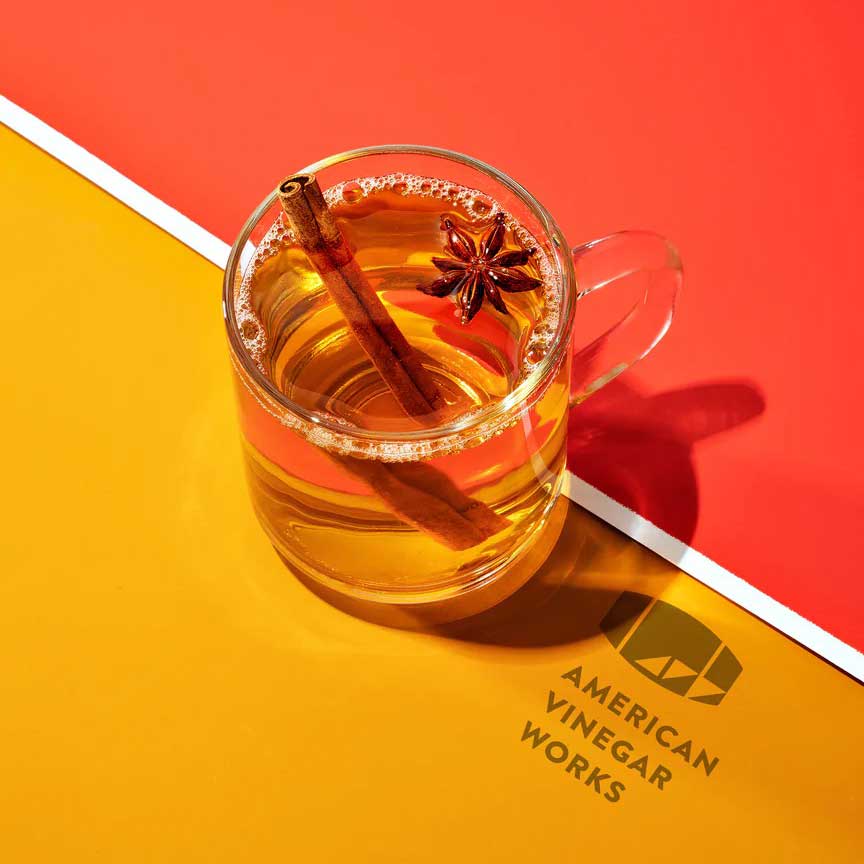Directions
Mix milk, heavy cream, and salt in a heavy large pot. Set over a medium flame and slowly bring the milk to boil. Stir occasionally and use a medium flame to prevent the milk from burning. It took me about 13 minutes to bring my milk to boil.
Once milk boils (it will rise to you quickly so you need to be by the pot to prevent a mess) shut off the burner. Add vinegar to the pot and stir enough to blend in the vinegar well. You will see that the milk begins to curdle almost instantly. Once that happens stop stirring and remove the spoon. Let the ‘milk’ sit in the pot undisturbed for 20 minutes. The resting period produces creamier and fluffier ricotta.
While the milk rests add a wet kitchen towel (product placement: our tea towels are lovely for this!) or layered wet cheese cloth to a fine mesh colander. Rest the colander on the rim of a bowl to catch the draining whey.
Once the milk has rested a full 20 minutes you should be able to see that it is fully curdled and floating at the top of the whey. Use a skimmer (easier) or a slotted spoon to slowly lift out the curds. Let them drain slightly in the spoon and place delicately in the prepared, lined colander. Repeat until you have removed all the curds.
Let the curds drain in the colander until they are to your preferred consistency. For me this was about 22 minutes. If you want wetter don’t drain as long, drier drain a bit longer. Feel free to taste along the way… Letting the curds drain on their own, rather than ringing them out with the cheesecloth or towel produces creamier and fluffier ricotta. Personally, I think that comes across as a more delicate and pleasant way to eat fresh ricotta but if you are cooking it further (e.g., in lasagna, etc.) and need a drier ricotta you can feel free to ring out. Just know that I will be judging silently in a corner.
Once it is ready you can use right away or transfer to a lidded container to refrigerate. This recipe made a little less than one pound of ricotta for me after draining. It will keep for about 2 days though it is at its creamiest and at its best immediately after draining and will harden a bit in the fridge after that.
Serving suggestions:
On crostini: You can blend fresh herbs and ingredients into your ricotta and toss them on toasted or grilled bread. Roughly you want 2 tablespoons of add-ins for each ½ cup of fresh ricotta. Sundried tomatoes are a nice add in or an herb mix of dill and chives. Serve as part of a charcuterie board by placing a heap over toasted bread and finish with salt/pepper to taste or a drizzle of finishing olive oil. Note on bread— coat a baguette slice or other bread slice with olive oil and toast or grill. Grilling is really lovely if you have access to a grill or grill pan—the black grill markets on the bread add a great flavor contrast and visual appeal. A sweeter treat is to put a dollop of a tarter jam like cherry or tomato over the unblended ricotta on top of unsalted crostini.
As dessert: On a small plate scoop about a ¼ cup of ricotta. Add fresh berries (mix of blueberries and blackberries works well) next to the ricotta. Drizzle honey over the ricotta only and finish with a pinch of flaky sea salt.
In eggs: Very soft scramble 3 eggs with plenty of butter. While still a little runny add ¼ cup of ricotta (plain or with herb mix) and blend well. Shut off burner. Plate over grilled bread and finish with salt, pepper, and chopped chives. Fancy, fast brunch!
Recipe Note
Pot: Stainless steel is great or an enameled cast iron—you need the pot to be non-reactive, heavy for heat retention/evenness, and large enough to accommodate the rise when the milk begins to boil.
Milk: As you can see there are very few ingredients here so the quality and flavor of what you use really matters. That said, you can use just about any milk with the exception of ultra-pasteurized milks which create problems with curdling. If you are curious, I used local (but pasteurized) milk from Jersey breed cows because their milk has a lovely and fatty taste.
Timing: The recipe is pretty easy but you will see there is a good amount of waiting that you might be tempted to rush by. Please wait at each step. It will produce a much better cheese for you.
Authenticity: This is the small print… but the truth is that this is not true ricotta. As some of you may know ricotta—and several other similar cheeses from countries in the Mediterranean area— is actually made from whey left over from other cheese making and often from sheep milk whey. I think that you will very much enjoy this recipe and that it will be shoulders above what you buy in the store BUT I didn’t want to leave you in the dark on authentic ricotta manufacturing since we are using milk and not whey to make our scandalously delicious “ricotta”.


